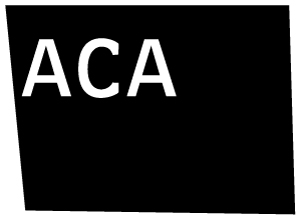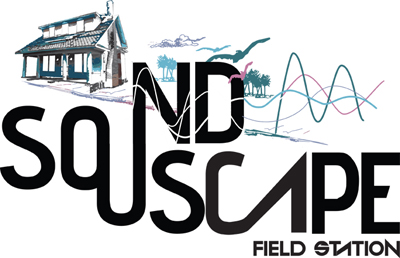
ACA Soundscape Field Station at Canaveral National Seashore is a partnership between the Community Arts department at Atlantic Center for the Arts and Canaveral National Seashore. It is the first of its kind in the United States dedicated to preservation of natural sound, following in the tradition of other types of successful U.S. National Park Service artist-in-residence programs located in more than 100 parks throughout the country.
APPLY for the 2025 residency by clicking here
Application Deadline: July 26, 2024 at 11:59 PM EST
Support this program by clicking here
“This exciting endeavor promises to strengthen the connection between science and art.” – Laura Henning, Chief of Interpretation at Canaveral National Seashore
2024 ARTISTS IN RESIDENCE
From February 10 – March 16, 2024, artists Gordon Hempton and Perri Lynch Howard worked at the Doris Leeper House at Canaveral National Seashore.
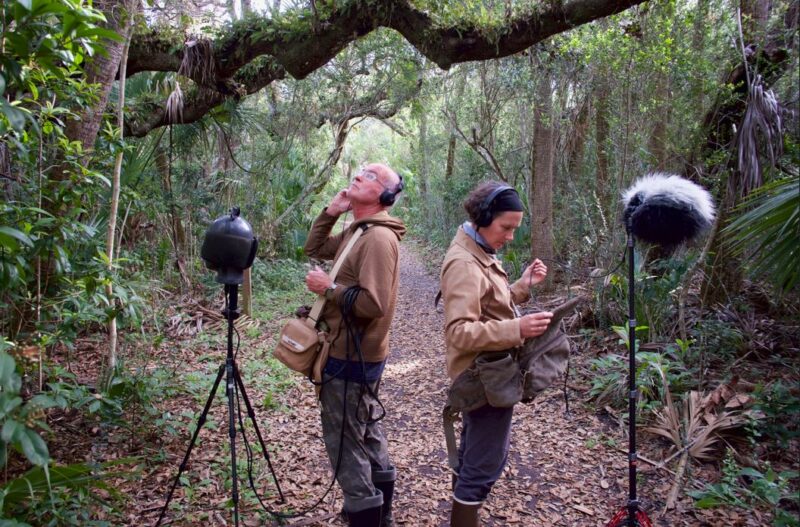
Experience their creative contribution to the residency: “Hear Me Out” >> https://www.perrilynchhoward.com/sound-art/hear-me-out/
Hear Me Out is a visual and sound art piece that asks the question, “do artists have a responsibility to defend the beauty that inspires their creative work? We quietly nod yes. The voice of Doris Leeper, here and hear. The dawn chorus and evening insects, here and hear. This work…stands as a pilot project for a deeper investigation into the synergistic relationship between people and places.” – Perri Lynch Howard
Hempton and Howard were embedded in the soundscape of the Eldora community for five weeks, “listening for pockets of quiet between bustles of commuter traffic overland, and overpopulated airspace above. We drew inspiration from Mark Twain, John Muir, Walt Whitman, Shakespeare, and Doris ‘Doc’ Leeper. If these fierce luminaries hadn’t done their work, we couldn’t do ours. Sometimes in tandem, and otherwise in sequence, we led sound walks and created soundscapes for blind youth and community members longing for quiet at Canaveral National Seashore.”
For details of their community engagement, visit > https://atlanticcenterforthearts.org/event-or-exhibition/2024-soundscape-field-station-community-artists-in-residence/
About the artists:
Gordon Hempton
“I live near Olympic National Park in the rugged northwest corner of Washington State, quiet enough to be a recording studio–and it is. In the photo to the left I am recording Nature’s Largest Violin. I’ve positioned my microphone system that replicates 3-D human hearing inside a giant Sitka spruce log. This tree grew in the nearby rain forest and then floated down the Bogachiel River before coming to a rest (temporarily) at Rialto Beach. The wood of this tree species has special properties that make it ideal for crafting violins, guitars, and other acoustic instruments because the wood produces a sound when exposed to the slightest vibration. But here, instead of a bow drawn across violin strings, the sound of distant surf is powerful enough to cause this Sitka log to produce its own deep, harmonic concert. This sound is impossible to adequately describe but easily heard. I am acoustic ecologist Gordon Hempton. I care very deeply about quiet. As The Sound Tracker® I have circled the globe three times over the last 35 years in pursuit of Earth’s rarest nature sounds—sounds which can only be fully appreciated in the absence of manmade noise. I hope that you will linger awhile on my website and enjoy the sonic wonders of our planet, and then join me in defending the live concert by visiting One Square Inch of Silence.”
https://soundtracker.com/
https://www.quietparks.org/
Perri Lynch Howard
“My artistic expression has, since the beginning, involved the relationship between human perception and sense of place. I am inspired by our inner navigation – the patterns, methods, and sequencing we bring to our experience, even when compromised by storm events, dropped signals, navigational lapses, and missed connections. Even when chaos presents, there is always an underlying grid, a place into which we all drop a pin, each day of our lives, to stake out a map, a direction, a sense of belonging. We gravitate towards that last known location, a point on the horizon, our nearest friend.
From the genesis of the early artworks in painting and printmaking, my practice has grown to incorporate sound, sculpture, and immersive environments. The paintings and prints are multi-layered, committing real places, imaginary landscapes, and perspectival lines as one seamless whole. The patterning of light and tides, wind vectors, cairns, and landmarks all figure significantly in the two-dimensional works, relating to the “there-ness” of everything.
Sound is an intensely engaging, yet often overlooked, component of landscape and space. Over time I awakened to this spatial force, and have integrated audio components with the visual art, creating immersive environments that work in concert with the outside world.
Originally from Marblehead, Massachusetts, I received my BA from The Evergreen State College, BFA from the Univ. of Washington, and MFA from Cranbrook Academy of Art (2001). I have completed artworks on location in Covas Do Rio Portugal, the Mamori Region of the Amazon, Civita Di Bagnoregio, Italy, and in South India as a Fulbright Scholar. VMG Studio is located at TwispWorks in the beautiful Methow Valley of Washington State.”
https://www.perrilynchhoward.com/
PAST ARTISTS IN RESIDENCE
2023
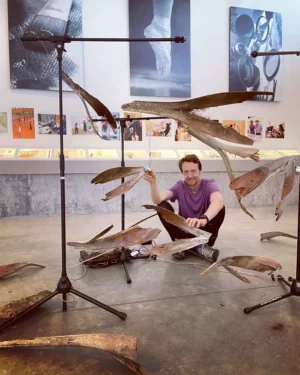
In 2023, we welcomed sound artist, Jacek Smolicki to the ACA Soundscape Field Station from February – March 2023. Smolicki is a Fulbright Scholar who was pursuing an international post doctorate at Simon Fraser University and Harvard University, funded by the Swedish Research Council.
During his residency with ACA, he involved the local community in his creative work while living at the Doris Leeper House at Canaveral National Seashore. He says, “As a sound artist and currently a postdoc researcher within soundscape studies, acoustic ecology, and environmental humanities, I have been drawn to places with complex histories and uncertain futures. I have been particularly interested in borderland territories, the so-called ecotones where several different ecosystems co-exist, collide, and interact.”
Listen to his creative contribution to the residency here: “One Step at a Deep Time” a Soundwalk composition for the ecotones of Canaveral National Seashore >> http://para-archives.on-going.net/onestepatadeeptime/
For details of his outreach events, visit > https://atlanticcenterforthearts.org/event-or-exhibition/2023-soundscape-field-station-artist-in-residence/
2022

From February 28 – March 14, 2022, Mary Edwards lived and worked at the Doris Leeper home in Canaveral National Seashore. She used her time to design a site-specific sound art installation welcoming the public to ponder unique listening prompts which contributed to the creation of a published book. This exhibition was on display from March 30 – May 2, 2022, with the final book release (in December) chronicling the experience. Mary’s book Conservation/Conversation can be ordered online via this link: https://www.blurb.com/b/11390395-conservation-conversation
Mary says about this work, “As a composer and sound artist whose objective is to enhance the listener’s spatial-sensory, historical and ecological awareness, I am excited to have been given this remarkable opportunity, and for my encounters at Canaveral National Seashore and it’s biodiverse, sonically enriched terrain. Listening to, and describing sounds are an inherent and integral part of my process of understanding co-existences, and how conservation and conversation are etymologically, if not urgently, interchangeable. During my residency with the ACA Soundscape Field Station, I invite visitors to collaborate and engage in the immersive sound available to them in this distinctive environment. All sounds are habitable, and have the potential to be transformative once you get inside them. They can be simultaneously intimate and immense. What are the parallels between a gentle rainstorm and a NASA rocket launch in the distance? A whisper in your ear and the crashing of ocean waves, or the beating of a drum and your own heartbeat when all else appears silent? What do we know what to listen for, and how do we describe these sounds to others? How does the practice of deeper listening raise our awareness to soundscape ecology, our compassion, or stewardship and healing of each other and the wellness of the environment? These are some of the questions I will bring to the community, by way of our dialogue and posted signage located around the park. Afterwards, I will synthesize the responses to the questions with sounds and music I compose in response to the area, into text and a recording that will cinematically reflect the themes of temporality, impermanence, nostalgia and the natural world that recur throughout my work. Moreover, I hope to honor the collective experiences and the importance of listening to this wild coastal expanse with this creative work.”
Mary Edwards is an American composer and sound artist who uses the medium as an environmental or architectural element with the objective to enhance the listener’s spatial-sensory, historical and ecological awareness. Themes of temporality, impermanence, nostalgia, terrestrial/aquatic/airspaces and the natural world recur throughout her immersive installations and compositions. She says, “All sounds are habitable, and have the potential to be transformative once you get inside them. My process is to respond cinematically to their constructional and emotional aspects by locating a narrative and cultivate a soundtrack one may associate with acoustic intimacy. It is an extension of my relationship to the natural and human-made environs, its community, and their histories that reveal themselves in these spaces I explore, each being simultaneously intimate and immense.”
In 2021, The Grimshaw-Gudewicz Art Gallery produced her first career survey of sound works in conjunction with Something to (Be)Hold, her first large-scale public sound installation. Other projects have been commissioned and/or curated by The Provincetown Museum, The Beach Institute, Tybee Island Marine Science Center, The Joshua Tree Cultural Preservation Center, Indivisible Gallery, 429 Architectural Spaces and The William T. Davis Conservancy. Her most recent essays and writing can be found in Invert/Extant (U.K.), The Mentor that Matters series, and the anthology, Joy Has a Sound: Black Sonic Visions. In 2022, she will participate in The Arctic Circle Residency sailing expedition around Svalbard (the Norwegian archipelago between mainland Norway and the North Pole), where she will collect, then convert, glacial geology and ocean data into music and sound. She currently lives between Savannah and New York.
2021
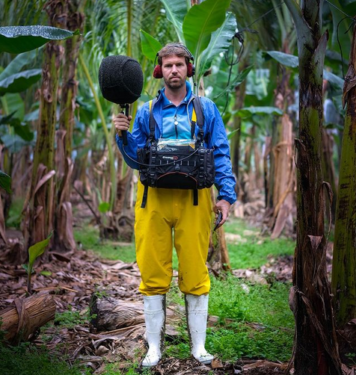
Félix Blume is a French sound artist who has created installations and sound art throughout the world, including Chile, Mexico, Thailand, Brazil and Haiti. He says, “my work focuses on the listening experience as a shared moment during the recording, as an invitation to the audience to listen. I often work with communities in a participative way. I like to learn from places and people, from the relation between inhabitants and their environment. My microphones and sound recording gear are a pretext to meet people, to listen to them, to receive sounds and capture them. I am interested in the dialogue between humans, animals and geophonic sounds. I believe there is a very deep relation between our way of listening and our way of producing sound, how we become part of a place.”
https://felixblume.com/acasoundscapemap << LISTENERS MAP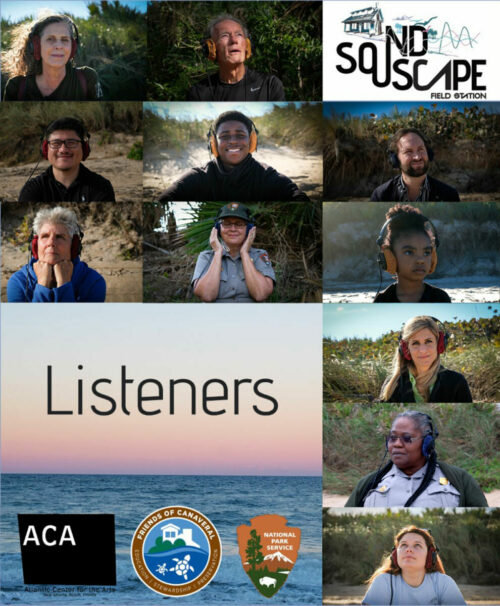
Listeners is a sonic cartography of Canaveral National Seashore through its inhabitants. Rangers, neighbors, and visitors have been invited to share a listening experience of their favorite place in the park. They’ve been portrayed on video while listening and are now inviting the audience to listen with them.
Félix says about this project, “The residency at Canaveral National Seashore has been a unique opportunity for me to explore a beautiful natural soundscape, between islands, the lagoon, the pine woods and the ocean. It’s an area I had not visited before, and is very rich in term of sounds and biodiversity. As on many of my previous residences and projects, I am surprised by the place and the people living there. I try to understand how inhabitants listen to their daily soundscape, learning which sounds they like or not, and which places they would recommend to listen and record. I like to be guided by the encounters of people and places. This residency has been a unique experience of learning and listening on-site, among other listeners of the park. As many of my previous projects, I’ve done it in a collaborative way, with the people living nearby and working in the park: rangers, visitors, neighbors, and other possible encounters. The Listeners project shows the diversity of sounds existing at Canaveral through the diversity of listeners. I have involved different generations, from different backgrounds and approaches. Of course, people don’t listen equally to sounds, even being in the same place at the same moment. Our brain is constantly erasing some sounds or focusing on others. I like this subjectivity inherent in the act of listening, which is not passive at all, but on the contrary a very active state. My project is a listener’s cartography of the park. The project is participative, and the collaborators have chosen a specific place and time of the day to go and listen. The sounds of the park were amplified live in real time using microphones, then heard by the listener through headphones, as it is an easy way to focus on listening. The possibility to amplify the sounds offer a more accurate representation of the surroundings. Each listening session has been recorded both in sound (what the microphones are capturing) and video (portrait of the listener). The material is now plotted on an interactive online map of the park, giving everyone the opportunity to listen with one of the listeners of Canaveral National Seashore.
Experience this creative work by clicking this link:
https://felixblume.com/acasoundscapemap
2020
In 2020, the artist in residence was Dr. Nathan Wolek of Stetson University. His involvement in the program helped support the inaugural year, and continues to make a strong impact on local awareness of soundscape ecology.
November 14, 2020 – Soundwalk with 2020 AIR, Dr. Nathan Wolek
December 5, 2020 – Opening Reception for sound art exhibition by 2020 AIR, Dr. Nathan Wolek
Audio excerpts and text from the exhibition can be accessed on the event page.
Interview with the artist
2019
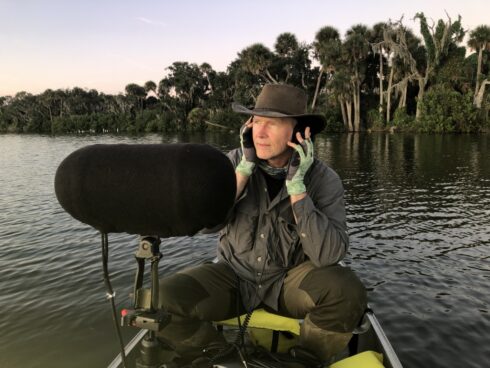 The program was inaugurated in November 2019 when we welcomed artists from Wild Sanctuary, the internationally acclaimed soundscape field research and sound arts group founded by Dr. Bernie Krause. Dr. Krause, a world-renowned bioacoustican, was a key figure in implementing natural soundscapes as a resource for the U. S. National Park Service. His sound art has been installed in museums around the world, including the Smithsonian Institution, American Museum of Natural History, and Chicago Academy of Sciences. Dr. Krause’s colleague, Jack Hines was on-site to collect audio recordings at the 2019 residency. Both artists worked together on the final creative work, and led public outreach throughout Volusia County.
The program was inaugurated in November 2019 when we welcomed artists from Wild Sanctuary, the internationally acclaimed soundscape field research and sound arts group founded by Dr. Bernie Krause. Dr. Krause, a world-renowned bioacoustican, was a key figure in implementing natural soundscapes as a resource for the U. S. National Park Service. His sound art has been installed in museums around the world, including the Smithsonian Institution, American Museum of Natural History, and Chicago Academy of Sciences. Dr. Krause’s colleague, Jack Hines was on-site to collect audio recordings at the 2019 residency. Both artists worked together on the final creative work, and led public outreach throughout Volusia County.

Listen to the creative contribution at the link below. It is the first ever sound tour of Canaveral National Seashore! Open your ears, close your eyes, and let it take you on a journey through the various habitats and moods of nature found at the seashore > https://www.nps.gov/articles/000/artist_2019.htm
ABOUT THE PROGRAM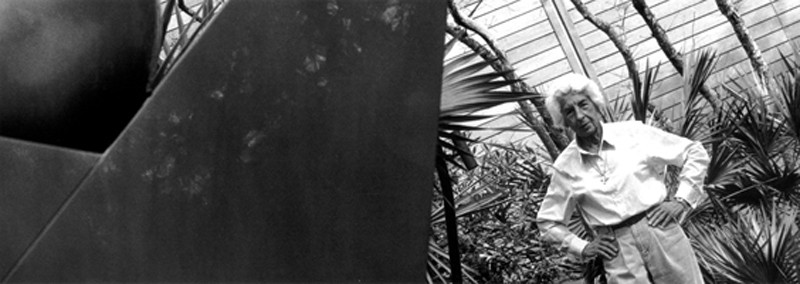 The legacy of artist and environmentalist Doris Leeper has connected Canaveral National Seashore and Atlantic Center for the Arts for many years. Doris ‘Doc’ Leeper lived in a turn of the century home (listed on the U.S. National Register of Historic Places) on the banks of Mosquito Lagoon in the Eldora community from 1958 to 1975 where she painted and created sculptural works. She is the founder of Atlantic Center for the Ars and was instrumental in the creation of Canaveral National Seashore to protect the beauty of this wild coastal habitat from development.
The legacy of artist and environmentalist Doris Leeper has connected Canaveral National Seashore and Atlantic Center for the Arts for many years. Doris ‘Doc’ Leeper lived in a turn of the century home (listed on the U.S. National Register of Historic Places) on the banks of Mosquito Lagoon in the Eldora community from 1958 to 1975 where she painted and created sculptural works. She is the founder of Atlantic Center for the Ars and was instrumental in the creation of Canaveral National Seashore to protect the beauty of this wild coastal habitat from development.
Canaveral National Seashore and Atlantic Center for the Arts maintain a formal collaboration that carries on this legacy. Leeper’s home at Eldora is part of an environmental artist residency program designed to provide a creative platform where sound artists and scientists can discover sustainable solutions and raise awareness of sound as a natural resource.
From urban design to wildlife ecology, the sounds of our environment tell a story of wildlife biodiversity and the health of people living in that community. The World Health Organization has compiled evidence that, “the burden of disease from environmental noise” can cause:
- anxiety, hypertension, sleep deprivation, and high blood pressure
- lack of concentration, loss of hearing, and loss of communication
In addition, adverse effects of human-based noise on wildlife cause:
- changes in animal behavior, including, mating, navigation, migration, and feeding
(source – National Park Service Natural Sounds Division)
ACA Soundscape Field Station at Canaveral National Seashore is a unique program designed as a community residency, with the goal for each artist-in-residence to share and find innovative approaches that give us greater knowledge and understanding of the importance of a healthy and balanced soundscape for current and future generations. This residency also aligns with the National Park Service goals of Canaveral National Seashore to preserve and protect the outstanding natural, scenic, scientific, ecologic, and historic values of certain lands, shoreline, and waters of the State of Florida. This program invites sound artists, musicians, composers, field recordists, and soundscape researchers to live and work for 5 weeks in the Eldora community at Canaveral National Seashore.
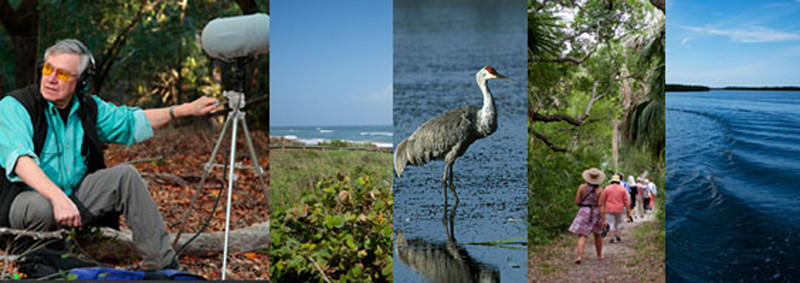
SUPPORT
ACA Soundscape Field Station at Canaveral National Seashore is funded by contributions from individuals, private foundations, and educational institutions. Recent support was given by Friends of Canaveral, Atlantic Center for the Arts, the City of New Smyrna Beach, Latitudes Margaritaville Daytona Beach, the Cultural Council of Volusia County, individual donors, and made possible by Canaveral National Seashore.
Support this program by CLICKING HERE or contacting Eve Payor, ACA Community Arts Director at epayor@atlanticcenterforthearts.org
DATES
Residency dates: February 22 – March 29, 2025
APPLY for the 2025 residency by clicking here
Application Deadline: July 26, 2024 at 11:59 PM EST
The next biennial call for artists will be 2027.
OUTREACH & DONATIONS
Community engagement is a key to the success of this program. It is vital for artists to use this residency for environmental and arts advocacy that connects youth and adults to the goals of ACA Soundscape Field Station at Canaveral National Seashore. These engagement activities contribute to the public understanding and appreciation of Canaveral National Seashore, offering an opportunity to experience the park in new ways. Each resident is required to volunteer at least 3 hours each week to interact with park visitors and facilitate community outreach. This community outreach will be a collaborative effort with Atlantic Center for the Arts (ACA) and Canaveral National Seashore (CANA) staff.
In a continuing effort to offer interpretive programs to the public, artists are asked to donate a tangible creative work produced at the residency. These works may take the form of exhibitions, digital recordings, slide lectures, visitor center resources, or video documentation. The artist maintains copyright to the creative work and agrees to grant permission to ACA and CANA to use and publish (including CANA website) for the purposes of interpretation, exhibits, and education. This donation does not include mechanical rights to reproduce or distribute the creative work for profit without written permission from the artist. Any creative works used by ACA and CANA will include the language: “This creative work was produced under the Atlantic Center for the Arts artist-in-residence program at Canaveral National Seashore.”
CURATION
The selection process is managed by Atlantic Center for the Arts and Canaveral National Seashore. This committee will select one application per biennial call for artists* to live and work on-site at Canaveral National Seashore Apollo Beach for up to 5 weeks. Selections will be made based on merit and how an artist’s work can advance the mission and goals of ACA Soundscape Field Station at Canaveral National Seashore. Sound art installations are welcome, but limited to the parameters of National Park Service guidelines. No additional stipend is provided for technical support.
Committee Members
Eve Payor, ACA Community Arts Director
Sadie Woods, ACA Curatorial & Residency Director (MAiR)
Ivan Riascos, Artist and Educator
Laura Henning, Chief of Interpretation at Canaveral National Seashore
Dr. Nathan Wolek, Professor of Digital Arts at Stetson University
The curation committee will treat all applicants fairly, regardless of race, religion, sex, disability, national origin, age, or marital status.
* it is possible to house more than one artist per residency, if the team is working towards the same goal. We encourage cross collaboration between artists and scientific researchers.
STIPEND
Each residency will offer one artist stipend of $2400 for a full 5-week program.
FOOD
Each residency will offer an additional food stipend of $50 per day. The nearest grocery store is 15 minutes driving time from the park. The kitchen at Canaveral accommodations contain a refrigerator, microwave, oven, stove, and basic accessories.
HOUSING
Canaveral National Seashore manages and maintains two private houses located within the Eldora community in Apollo Beach (North District). Depending on availability, one of these houses will be offered. Each are fully furnished on a remote stretch of wilderness near the Eldora State House and public trails. Each are climate controlled and ADA compliant. If both houses are unavailable for any reason, artists will be offered accommodation at ACA main campus (1414 Art Center Ave., New Smyrna Beach) with 24-hour access to Canaveral National Seashore for creative purposes.
LAUNDRY
Bed and bath linens are provided. Laundry facilities are located at the maintenance facility in the park.
INTERNET
The Eldora community is a remote wilderness area of Canaveral National Seashore. There is cell phone reception, but no cable internet. It is recommended to use your phone data as a hotspot for wifi inside the house. Wifi is offered by the park at the Visitor’s Center.
ACCESS
Canaveral National Seashore Apollo Beach is accessible from New Smyrna Beach via US Hwy 1. The closest airport is Daytona Beach (DAB), 45 minutes driving time, or Orlando International (MCO), 90-120 minutes driving time. All artists-in-residence will have 24 hour access to Canaveral National Seashore at the Apollo Beach north entrance.
https://www.nps.gov/cana/planyourvisit/maps.htm
Artists are responsible for transportation to the National Park and throughout their stay at the residency program. ACA staff can assist with short distance transportation while in residence, such as grocery trips and outreach events.
